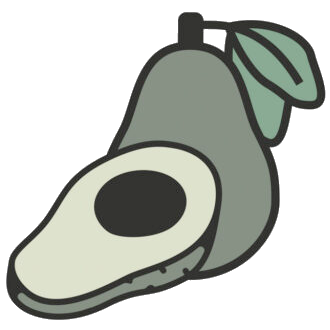WHITE GUAVAS
When I first tasted the Santa Paula tree-ripened white guavas in the early ’90s, Kern’s Nectar came to mind. The flavor profile was very similar—but not syrupy like the ’70s beverage. It had a firm softness that was pleasant to bite into, and its flavor was sweet and strong yet not overpowering. The skin was thin and delicate, and the entire fruit—skin, seeds, and core—was 100% edible. Its scent was lovely; while not overwhelming, it made itself known in any closed room or refrigerator.
They’re grown in Santa Paula and harvested from December through March. Many non-Western cultures prefer to eat unripe white guavas while they’re still quite firm. This is how they’re typically purveyed in most ethnic grocery stores—super hard and not at all fragile. Brokaw Ranch Company, however, allows them to tree-mature and ripen. While this increases fruit fragility and perishability and necessitates gentle handling, the result is a perfect biting texture with a beautiful flavor and aroma that screams “guava.” This enhanced guava experience is what Farmers’ Market retail customers have come to expect, as do many chefs and mixologists.
Another white guava anecdote involves juice. Many years ago, we pulled out my Juice Man Jr. and blended a bunch of grapes with maybe three guavas. The resulting juice had a delicious flavor that was completely dominated by the guava. While my preference is to eat a lot of them, small amounts of white guavas can go a long way.
PASSIONFRUIT
Some of you might know that the Santa Paula ranch was hit hard by the Thomas Fire in December 2017. Fifty percent of the avocado groves were lost, and while a five-year avocado replanting plan was being implemented, it was decided that something should be grown in the interim—something that would begin producing more quickly. Passionfruit seemed like a viable candidate, and some vines were promptly planted in one of the most severely burned areas. Sure enough, it wasn’t long before the harvest was underway. At our Farmers’ Markets, we post an interesting picture showing how they were planted in a burned-out avocado block, using the deceased avocado tree stocks to support the trellis wires.
Passionfruit is wildly popular with both our retail and restaurant clients, yet I find them quite odd. My wife adores them, and while I like them, they’re difficult to eat. They’re also surprisingly light in weight, as the pulp shares space inside the thick shell with air. I really appreciate that they’re so durable and not fragile, but I find assessing individual fruit quality challenging. However, I guess the magic happens in Santa Paula—not where we pack them in Watsonville—since our clients and coworkers absolutely love them.
The passionfruit harvest begins in November and lasts into April.
HAYWARD KIWIS
This is an unusual fruit for Brokaw Ranch Company. It’s deciduous, meaning that it loses its leaves and goes dormant in the winter. The crop is ideally harvested all at once and then sold out of storage. Unlike virtually every other non-deciduous fruit Brokaw Ranch Company grows, a Hayward kiwi requires chill time in order to go dormant and set fruit—this is why they’re grown at the Soledad ranch.
Kiwis ripen most reliably when harvested at a 6.5% sugar content while still firm. Ripening performance decreases if harvested with more or less sugar, and if left to vine-ripen, the fruit will first shrivel and then soften unevenly.
Kiwi sugar content usually reaches 6.5% in late October or early November. The entire acre is harvested at once, the kiwis are placed in a refrigerator with an ethylene filter, and then they are removed for ripening and purveying incrementally over the following three to four months.
We are so fortunate that Brokaw Ranch Company grows kiwis. In my opinion, they are the best-tasting fruit available in the winter and early spring, rivaled only by the finest mandarin varieties. And the Hayward variety grown on the Central Coast is the absolute best. Most California kiwi production is concentrated in the northern San Joaquin Valley. Given that they hang on the vine until late October, valley kiwis are subjected to extremely hot temperatures right before harvest. However, this isn’t the case for kiwis grown in the much cooler Central Coast. Brokaw Ranch Company kiwis, along with those from fellow growers in the area, are noticeably healthier, ripen more evenly, and boast superior juiciness, texture, and flavor.
The kiwis are typically purveyed starting in December and continue until they run out in March or April.
OTHER SANTA PAULA SUBTROPICAL TREE FRUITS
Brokaw Ranch Company grows many varieties of cherimoyas, though after harvest, it’s difficult to distinguish one variety from another. Like avocados, cherimoyas are harvested while firm and ripen off the tree. Not many are grown, and Brokaw Avocados carries them intermittently from December through April.
Brokaw Ranch Company also grows exceptionally delicious California mangos. While not quite as sweet as imported varieties, they still contain plenty of natural sugar, ripen beautifully, and have a perfect, fiber-free texture. In my opinion, this might be the tastiest fruit Brokaw Ranch Company produces. Since they can be fast-tracked to clients, they are allowed to mature on the tree longer than imported counterparts—a key factor in enhancing their rich flavor and overall quality. Harvest runs from July through September.
For a couple of seasons, Brokaw Ranch Company also produced small quantities of freshly harvested, incredibly flavorful lychees. Easy to peel and absolutely delicious, they were a customer favorite. Unfortunately, the few trees located in Santa Paula suffered significant damage from the Thomas Fire. While only a couple of producing trees remain, we hope to plant more in the future. The lychee harvest window is September and October.
